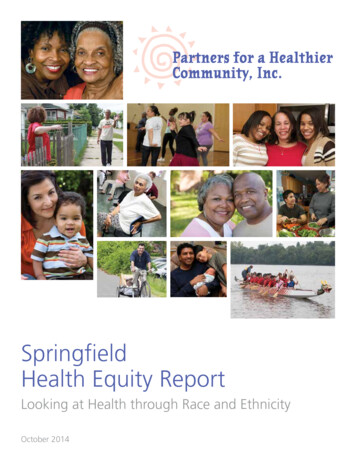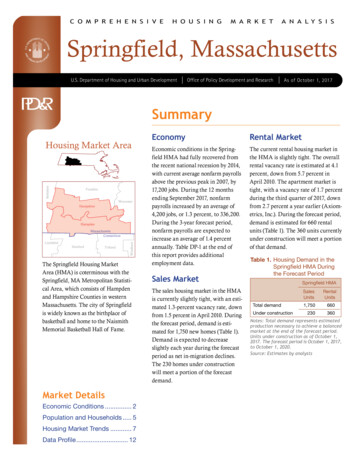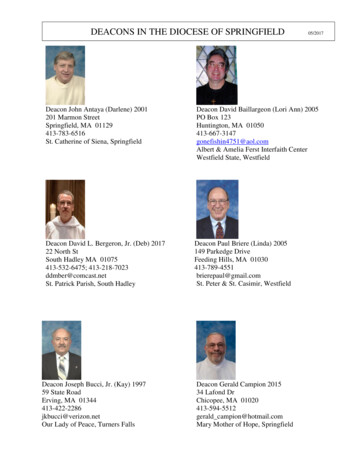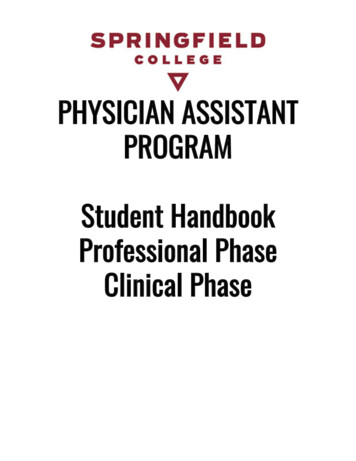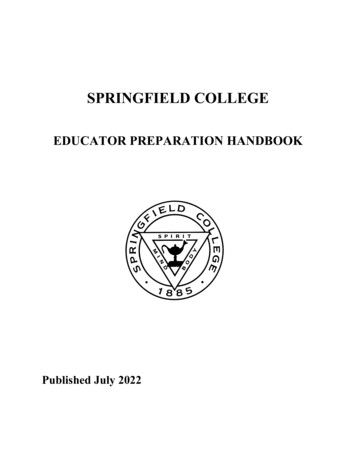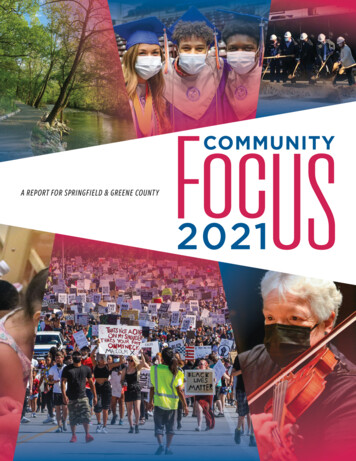
Transcription
A REPORT FOR SPRINGFIELD & GREENE COUNTY
INTRODUCTIONProduction & SupportThis project was completed with support fromthe following organizations, whose leaderspledge to use the information in the report toguide their future decision making:COMMUNITY FOUNDATIONOF THE OZARKSJUNIOR LEAGUE OF SPRINGFIELDSPRINGFIELD AREA CHAMBEROF COMMERCESPRINGFIELD-GREENE COUNTYLIBRARY DISTRICTUNITED WAY OF THE OZARKS Dr. Jonathan Groves, Facilitator, CommunityFocus Report — Drury University Morey Mechlin, Chair, Community FocusReport Steering Committee — CommunityFoundation of the Ozarks Board Member Louise Knauer and Aaron Scott, editing anddesign — Community Foundation of the Ozarks Olive Thompson, social media intern — DruryUniversity/Community Foundation of theOzarks Sony Hocklander, communicationssupport — Sony Hocklander Creative LLC Cover photos provided by: Rebecca Miller,Drury University; Springfield SymphonyOrchestra; Springfield-Greene County ParkBoard; Springfield Public Schools; SpringfieldArea Chamber of Commerce; SpringfieldPolice Department; and Habitat for Humanityof Springfield, MissouriThe 2021 Community Focus Report: A Reportfor Springfield & Greene County is a summaryof information compiled and evaluated by manyindividuals and subcommittees. Additionalinformation, data and resources are available onthe website dedicated to this report.Please visit: SpringfieldCommunityFocus.org SGFengage.org facebook.com/SGFCFR twitter.com/sgfengage #SGFCFRAcknowledgementsThis report would not be possible without the contributions of these community participants, whose input and guidance helped developand present the Blue Ribbons, Red Flags and Community Themes. (Steering Committee members are highlighted in bold.)Joel AlexanderJasmine BaileyKate BairdJoselyn BaldnerBob BeloteJoshua BestTeresa BledsoeAlexis BrownKimberly Shinn BrownLoring BullardRonda BurnettGreg BurrisShelby ButlerMandy Buttgen-QuinnLeslie CarrierDana CarrollCarla DeSilva-CarverMike ClemNicole ChiltonMatt CrawfordJennifer CrouchHeather CoulterCynthia DaviesChris DavisChristy DavisLaurie DavisEmily DennistonBridget DierksRick DinesBeth DomannJenny Fillmer EdwardsJason ElmoreJeremy ElwoodDerrick EstellLaura FarmerJim FisherBrian FogleLeslie ForresterGloria GalanesAbby GlennStephen HallBill HammittJacque HarnessJessica HawkinsCOMMUNITY FOCUS REPORT 2021Daniel HedrickSony HocklanderNicole HoltMolly HoltmannDavid HutchisonKris InmanRachel JohnsonAddison JonesBob JonesBreana KavanaughErrin KemperLance KetteringWinter KinneLinda KirchnerLouise KnauerMary KromreyMike KromreyAllen KunkelLisa LangleyMatt LemmonNichole LemmonErica LittleLexi LockeJustin LockhartNatasha LongpineBarbara LucksMarty LueckJohn MackeyDan MalachowskiJamie McGranahanAnne-Mary McGrathKeisha McMillenMorey MechlinKaren MellingerKristen MilamRebecca MillerJohn MontgomeryDoug NeidighNick NelsonMatt NoblettKathleen O’DellJohn Oke-ThomasAvery ParrishLinda PasseriDan PattersonDave PenningtonAngela PerrymanNicole PiperFrancine PrattYvania Garcia-PusateriCrystal QuadeBret RangeKim ReserCarrie RichardsonAllison RobertsonRoddy RodgersRandy RussellAmy St. JohnCaleb SandersShane SchoellerAaron ScottCora ScottSusan ScottCara ShaeferFrancis SkalickyStephanie SmallwoodStacie Armstrong SmithMary Lilly SmithTim SmithAngie SnyderSean SpyresAmanda StadlerGeoff SteeleMike StevensBrent StockMarc TrubyDiana TyndallMeg WaglerAshley WaldenAnne WallenmeyerRandall WhitmanJamie WillisLarry WoodsRusty WorleyVonda Yarberry
Welcome to the 2021 Community Focus Reportby Morey Mechlin, Steering Committee Chair, and Dr. Jonathan Groves, FacilitatorFifteen years after the first Community Focus Report, the2019 edition highlighted several improvements throughout the Springfield/Greene County area: A strong, growing economy; a vibrant arts community; a willingness to investin schools, trails and infrastructure. Ongoing challenges such2021 Community Themes ———————————— 2as poverty, child abuse and mental health issues remained, butImpact of COVID-19 —————————————— 4the October 2019 event that shared the report highlighted caseAbout the Social Determinants of Health ———— 6studies of success, as well as a sense of optimism.Health Care Access & Quality ————————— 6As 2020 began, scientists identified a novel coronavirus thatEconomic Stability —————————————— 8had begun spreading throughout the world. By March, healthEducation Access & Quality —————————— 9officials had declared the situation a pandemic, one that evenNeighborhood & Built Environment ————— 10tually inundated health systems and led to community shutSocial & Community Context ————————— 11downs around the world, including in Springfield and GreeneDiversity, Equity & Inclusion ————————— 12County. Since that time, the changes wrought by the COVIDInformation Resources ———————————— 1419 pandemic have disrupted every facet of our lives, physical,2021 Blue Ribbons & Red Flags by Topic ———— 16mental and spiritual.To reflect this historic moment, the Community FocusThe report also includes an intentional focus on diversity,Report’s steering committee is presenting our community’sbiennial report card of strengths and challenges in a vastly dif- equity and inclusion, a major theme in 2021. Committee member Francine Pratt, director of Prosper Springfield, explainsferent fashion.In advance of this printed report, 11 white papers tracking how to apply an equity lens to understand how issues andthe Community Focus Report’s usual topic areas were released decisions may affect historically under-represented groups difon a new website built by the Springfield-Greene County ferently — often more deeply — and ask, “Who is kept out ofLibrary District. In addition to focusing on three specific Blue participation?”Since 2004, the Community Focus Report has provided aRibbons and Red Flags for each topic, the papers also examined the pandemic’s impact. We are grateful for the continuing data-driven snapshot of our community to help us improvecommitment of the Library and the report’s other support- Springfield and Greene County. How we move forward is up toing partners: the Community Foundation of the Ozarks, the us as a collective community — among nonprofit organizationsUnited Way of the Ozarks, the Springfield Area Chamber of and churches, schools and government institutions, citizensas well as public leaders. No single group or area of expertiseCommerce and the Junior League of Springfield.Unlike previous editions, this printed summary centers on alone can eliminate all of our Red Flags; as this report reveals,community health to understand how we coped and how we there are connections and links, often not immediately apparmight regain our momentum post-pandemic. The Blue Ribbons ent, that can result in unintended consequences. What mayand Red Flags from the white papers have been grouped by the resolve a problem in one area might create another elsewhere.The committee’s hope, now as then,Social Determinants of Health, definedis that this report provides a startingby the Centers for Disease Control andENGAGE ONLINEpoint for conversation in our commuPrevention as “conditions in the placesnity, toward solutions that leverage ourwhere people live, learn, work, and play For the 2021 Update white papersstrengths to overcome persistent chalthat affect a wide range of health andfor each of the 11 topics coveredlenges and issues, together.quality-of-life risks and outcomes.”in previous reports, along with podcasts, news updates and more, visitspringfieldcommunityfocus.org. How do you define Springfield?Share your input on our communityat sgfengage.org.Table of ContentsCOMMUNITY FOCUS REPORT 2021 · 1
2021 COMMUNITY THEMESThe COVID-19 pandemic stretched ourcommunity in many ways — perhaps toomany.It affirmed our community’s resolve and ability to collaborate and innovate, especially duringthe pandemic’s first wave in 2020. Our medicalprofessionals and public officials led the waythrough uncertainty as health care workers tirelessly treated the sick. Teachers, business owners and artists explored new avenues to reachothers virtually. Neighbors developed creativeways to visit and support one another.But the pandemic revealed deepening fissures,too, as we isolated ourselves and fragmented. Adivisive national election season culminatedin a Jan. 6 attack on the U.S. Capitol. Scientifically validated solutions championed by medical experts were dismissed by some in favorof unverified and dangerous misinformationspread through social media. Locally, our vaccination rate remained lower than the state’s andthe nation’s going into the summer of 2021, andSpringfield soon made unwanted national headlines as our intensive care units filled again.As this printed report was being completed,the number of COVID-19 patients being treatedin Springfield’s hospitals had dropped from thehighest levels of the pandemic. An exhaustedTHEMES FROM PAST REPORTSThis is the third report in which the SteeringCommittee identified themes that emergedacross the 11 topical chapters. These are theearlier sets of themes:2017 Mental-healthassessment Poverty Continuedcollaboration Sustainable fundingfor communityneeds Infrastructureinvestment Civic engagement2019 Community mentalhealth Cooperation Diversity Economicopportunity Poverty andhomelessness Social capitalFor an archive of past reports,visit springfieldcommunityfocus.org.2 · COMMUNITY FOCUS REPORT 2021emergency corps was closer to relief as the percentage of Greene County residents 12 and olderwho were fully vaccinated surpassed 50%. Butthe divides had not healed.Against this once-in-a-generation backdrop, the steering committee developed six keythemes for the 2021 Community Focus Report,intended to capture the strengths and challenges of this moment. Our discussion considered the 66 Blue Ribbons and Red Flags from theseries of topical white papers released online toidentify these intertwined themes.THE NEED TO REGAIN MOMENTUMThe number of households in poverty — anoverall theme in the last two Community FocusReports — had been dropping in recent yearsthrough the collaborative work of organizationssuch as the Community Partnership of the Ozarks,Prosper Springfield and the Council of Churchesof the Ozarks. The City of Springfield’s ForwardSGF vision-planning process had increased civicparticipation as residents worked with public officials to plan our collective future. Businesses andthe arts community were thriving.The pandemic halted that progress, as shutdowns affected businesses and workers alike.Since March 2020, more than 600 GreeneCounty residents have died of COVID-19 variants,among 43,000 and counting confirmed cases.Though support from federal, state and localgovernments temporarily helped stem the tideof closures and evictions, the community mustrecapture the drive, innovation and progressfrom 2019 to move ahead into 2022 and beyond.Fortunately, local economic indicators areimproving. Unemployment has dropped topre-pandemic levels. Major construction projects are underway at Missouri State University,Springfield Public Schools and Drury University.And improvements to infrastructure, roads andtrails continue, with the ambitious Grant Avenue Parkway project connecting Bass Pro Shopsto downtown on the horizon.DIVERSITY, EQUITY & INCLUSIONIn the 2019 Community Focus Report, diversity emerged as a major theme, as SpringfieldPublic Schools and others launched equity initiatives to ensure success for people regardlessof background. In 2020, the deaths of GeorgeFloyd, Breonna Taylor and others inspired acontinuing national discussion on race thatresonated locally with a large march of supportthrough downtown.An inclusiveness survey released by the Mayor’s Commission on Human Rights in 2020found that nearly 45% of the 2,276 respondentsdescribed Springfield as “not inclusive” or “notvery inclusive,” and almost half reported having experienced or witnessed discrimination,because of race, ethnicity, gender, religion or age.These findings come as Springfield andGreene County have become increasingly diverse.The 2020 Census showed that 16% of the county’s population — and 19% within the city limits of Springfield — identify as a race other thanwhite only. The Hispanic population has grownto 5%, and the area’s LGBTQ community continues to grow. The City of Springfield, recognizing the importance of this area, has hired its firstdirector of diversity, equity and inclusion.And using an equity lens to understand howhistorically under-represented groups may bedisproportionately affected by organizationaland institutional decisions is now critical to ourcommunity’s collective success (see the essayby Francine Pratt on page 12).COMMUNITY HEALTHThe steering committee reframed the printedreport around this key topic, as our health system proved critical to our physical and mentalsurvival during the pandemic.CoxHealth, Mercy, Jordan Valley Community Health Center and the Springfield-GreeneCounty Health Department have workedtogether to battle repeated COVID-19 waves,and all other areas covered by the CommunityFocus Report depended upon the success of ourmedical community. Initiatives such as BurrellBehavioral Health’s Rapid Access Unit, highlighted in multiple Community Focus Report2021 Update white papers, show how the healthsector is exploring innovative ways to confrontour Red Flags across topics.Our community health goes beyond theemergency realm, however. Tackling upstreamissues such as poverty and mental healthremain important to dealing with addiction,domestic violence, suicide and other outcomesthat profoundly affect the quality of life inSpringfield and Greene County. And the pandemic revealed the need for trusted information
networks — beyond the fragmented socialmedia — to ensure a fact-based understandingof our local issues and challenges.THE COMMUNITY’S CHANGING IMAGEOur community continued to grow fasterthan much of the rest of the state, with GreeneCounty’s population expanding by 8.6% overthe past decade. But that rate of growth isslower than cities seen as desirable places inwhich to live, such as Austin, Texas, or Nashville, Tennessee.In recent years, leaders have put more focuson placemaking, developing distinctive amenities and offerings that not only bring skilledtalent to the area, but keep such professionals, entrepreneurs and innovators here. Education, transportation, business, the arts, theoutdoors — all play a role in creating an invitingplace that people from diverse backgrounds andperspectives want to call home.Those efforts, however, must be coupledwith confronting the persistent issue of poverty,the growing rate of crime, and the increasedincidence of issues such as domestic violenceand addiction arising out of undiagnosed anduntreated mental illness. And making surewages keep up with the rising cost of livingremains a vital issue.COLLECTIVE ACTIONSince the first report in 2004, collaborationamong our public and private institutions hasbeen a reliable, consistent community themefor Springfield and Greene County. But collaboration at the institutional level does not meanconsensus among individuals, as dissent overa variety of issues in recent months has madeapparent.For years, Springfield and GreeneCounty — driven by nonprofits and the faithcommunity — have provided a base of supportto address problems and help those in need.Through many organizations, we have volunteered time and donated resources to buildcommunity. The region now finds itself at a pivotal moment as longtime community leadersretire, and the next generation rises.ONGOING INVESTMENTSuccess requires investment, and over thepast few years, Springfield and Greene CountyCommunity at a GlancePOPULATIONSpringfieldGreene ,915CHANGE9,67823,741RACE & ETHNICITYGREENE COUNTYWhiteBlack/African AmericanAmerican Indian/Alaska NativeAsianNative Hawaiian/Pacific IslanderSome Other RaceTwo or More RacesHispanic or .1% .82010202077,62089.9%84,01690.5%201020192.09 103,800 6352.06 118,110 734HOUSINGSPRINGFIELDTotal UnitsOccupiedAverage Household SizeOwner-occupied ValueMedian RentGREENE COUNTYTotal UnitsOccupiedAverage Household SizeOwner-occupied ValueMedian Rent20102020125,38791.1%136,45092.4%201020192.28 125,500 7132.22 146,000 793CHANGE6,3960.6CHANGE 0.03 14,310 99CHANGE11,0631.3SPRINGFIELDMedian AgeMedian IncomeFamilies in PovertyFamilies in Poverty withChildren Under 18High School GraduateBachelor’s Degree or Higher2010201933.3 33,08215.6%33.1 36,85614.2%CHANGE 0.2 3,774 1.427.7%88.5%26.1%20.9%92.4%28.5% 6.83.92.420142019CHANGEWithout Health Insurance17.513.4 4.1GREENE COUNTYMedian AgeMedian IncomeFamilies in PovertyFamilies in Poverty withChildren Under 18High School GraduateBachelor’s Degree or Higher20102019CHANGE35.6 41,05911.2%36 46,0869.7%0.4 5,027 1.519.6%89.7%28%15.1%92.9%31.2% 4.53.23.220142019CHANGE14.7%10.7% 72.487.6Without Health InsuranceCOST OF LIVING2020 INDEXSt. LouisSPRINGFIELDKansas City(National average: 100)CHANGE 0.06 20,500 80residents have supported numerous infrastructure initiatives: A 168 million bond issue forSpringfield Public Schools is adding new buildings and resources for more than 23,500 studentsand their families; the renewal of the ¹ ₄-cent capital improvements sales tax and ¹ ₈-cent transportation sales tax ensure investments in roadsand capital projects over the next 20 years; andthe adoption of sewer-rate increases will supportwastewater, stormwater and overall water quality protection efforts into 2025.But investment is coming from other areassources: u.s. census bureau; americancommunity survey; council for communityand economic researchas well. Ozark Greenways, TrailSpring and otherorganizations are developing miles of trails andoutdoor recreation resources that proved critical to the community’s well-being during thepandemic. Numerous nonprofits continue toinject needed resources and programs to helpelevate residents out of poverty and personalstruggle. And organizations such as the Community Foundation of the Ozarks and the UnitedWay of the Ozarks help provide the financialstructures to make community improvementpossible for all.COMMUNITY FOCUS REPORT 2021 · 3
IMPACT OF COVID-19The pandemic impacted all 11 topic areas covered by the Community Focus Report. Butour community developed innovative, creative ways to overcome challenges and obstaclescreated by the historic disruption to our lives.In March 2020, Greene County and the Cityof Springfield issued orders temporarily haltingthe operations of many businesses and organizations; those orders were lifted in May. Thissection highlights solutions and effects in 10areas. Community Health, the focal point of thisreport, will be reviewed on pages 7 and 8, andgreater detail about the pandemic’s effect oneach topic area can be found in the 2021 whitepapers at springfieldcommunityfocus.org.The burden of caring for children weighsheavily on the backs of economically vulnerablewomen and women of color. Early childhoodeducators were some of the most vulnerablemembers of our society, particularly in the firstdays of the pandemic. They were on the frontlines without benefit of health insurance, adequate protective gear or sick leave.Developmental screenings of young children were down 75% from previous years, whichtranslated to an inability to make referrals fordelays. On the bright side, the child care community quickly determined how to continueserving and supporting families safely.BUSINESS & ECONOMIC DEVELOPMENTLike its counterparts across the country,Springfield Public Schools experienced dramatic changes. For the remainder of the 2019–20school year, students continued to learn at homethrough the SPS At Home online learning platform. To facilitate virtual learning, SPS ensuredthat every student had a device and adequateinternet service.Early in the pandemic, SPS staff completedwellness checks, connected families with support services, offered grab-and-go meals andprovided child care for health care professionals and first responders. At the beginning ofthe 2020–21 school year, SPS offered families achoice between modified in-person or fully virtual learning options.Enrollment for the 2020–21 school year wasaffected by the pandemic. The September 2020total student enrollment count was 23,139 totalstudents, down from 24,677 total students inSeptember 2019 — a decrease of 1,538 students.The pandemic affected the area economy insignificant ways. Unemployment rates temporarily skyrocketed in the first few months aftermandated lockdowns began, reaching 9.2%in Springfield in April 2020, according to U.S.Bureau of Labor Statistics. While those rateshave dropped to pre-pandemic levels, it’s likelythat many individuals have dropped out of theworkforce in the interim due to issues such assafety concerns or lack of child-care options.These reductions in workforce also are sureto exacerbate the existing skilled workforceshortage. Government relief efforts such as thePaycheck Protection Program, the CARES Act,the American Rescue Plan and other programsalso have helped to soften the immediate blow.(See sidebar on page 5.)Despite the pandemic’s enormous impact,area businesses demonstrated an ability to innovate. Many stayed open by adapting and changing operations. Restaurants switched to carryoutor delivery service; retail providers provided contactless and delivery-based options; manufacturers quickly picked up the ability to make personalprotective equipment for community use.EARLY CHILDHOODDuring the early months of the pandemic,54.7% of child care programs in Greene Countywere temporarily or permanently closed. By January 2021, Greene County had lost 715 licensedspots from pre-pandemic numbers. The numberhas rebounded slightly; however, more than 400slots were permanently lost due to closures andstaffing issues.4 · COMMUNITY FOCUS REPORT 2021EDUCATIONPUBLIC ORDER & SAFETYDuring the pandemic, the Office of Emergency Management’s Emergency OperationsCenter was activated both physically and virtually for a record 384 days. The EOC facilitatedcoordination for multiple agencies, departments, and organizations to respond to thehistoric circumstances. These efforts includedregular media briefings, weekly informationalcalls with community partners and coordinatingthe acquisition and distribution of personal protective equipment throughout Greene County.During the pandemic, Springfield-GreeneCounty 911 Emergency Communications sawa significant uptick in medical emergency calls,likely due to the desire to avoid hospitals forfear of the virus. While taking 911 calls, telecommunicators adjusted their questions to gathermore information about the caller’s health andkeep first responders safe.During the City of Springfield’s stay-athome order (April 6–May 4, 2020), officers wereresponsible for enforcing ordinance restrictions.Those duties continued through the year, asofficers responded to more than 1,500 calls formasking ordinance violations.HOUSINGIn March 2020, “home” became a differentplace. Those who had adequate housing weresuddenly isolated and forced to decide whomto allow inside, affecting those who dependedon caregivers. Others had to figure out how towork from home, and many had to create onlinelearning environments for their children. Thepandemic also created a real estate seller’s market with demands for larger homes.When news first came out about the dangersof COVID-19, those without homes became apriority. From April 2020 to April 2021, Community Partnership of the Ozarks helped placemore than 1,075 vulnerable individuals in areamotels to reduce potential exposure. Housingprograms, emergency shelters and supportiveservices started taking extra safety precautionsto prevent a COVID-19 outbreak.An eviction moratorium, created to protectrenters and tenants, depended on landlords andmanagers to be understanding while they werefaced with their own expenses. These shortterm solutions helped people maintain housing,but the long-term effects once federal assistance ends are yet to be seen.TRANSPORTATIONAfter the stay-at-home order, Springfield’straffic volumes decreased more than 40% anddid not return to “normal” until July of that year.Despite the reduced traffic, the Missouri Department of Transportation and the Highway Patrolreported increases in speeding and crashes.City Utilities Transit was affected by COVID19 with bus ridership at only 21% of the previousyear’s average. The CU transit division maintained operation of the farebox and use of thefront door on its buses by adding temporary
barriers in the bus’s operator (driver) area.CITIZEN PARTICIPATIONDuring the early months of the pandemic,city and health leaders held thrice-weekly healthnews briefings, along with virtual town halls, toprovide detailed information from local trustedsources. More people started watching and participating through multiple virtual channels,helping guide decisions. The City estimated thatvirtual channels increased citizen engagementby nearly 30% between 2019 and 2020.United Way of the Ozarks, along with theCity of Springfield, Greene County, the Community Foundation of the Ozarks and the Community Partnership of the Ozarks, also startedthe Have Faith Initiative. This effort broughttogether a broad array of faith leaders in Springfield and Greene County to coordinate theirresponse to the pandemic.The pandemic did affect overall volunteer levels, which were lower than previous years, as weredonations when many fundraising activities werepostponed or turned into virtual events. Manycorporate budgets tightened during the pandemic,too, making donations a challenge. There’s optimism, however, that volunteering in person isreturning with safety measures in place.ARTS & CULTUREFundraising for arts organizations shiftedgreatly during the pandemic. While the declineof corporate sponsorships continued, severalorganizations reported increases in individualdonations. To date, donations are down just 1%compared to pre-pandemic giving. Organizations were making smaller asks and receivingsmaller gifts, but patrons were deeply engagedin restarting the arts.The decrease in sponsorships remains a concern. Just like uncertainty facing the arts andculture community, for-profit partners alsoare dealing with dramatic shifts in business. Asemergency relief ceases, it is not assured thatprevious funding models are sustainable.While virtual program shifts are highlightedas a Blue Ribbon, the technological infrastructure for many was so outdated that it required amajor effort to make the change.PARKS, RECREATION & LEISUREDuring the most isolating parts of theFederal support, nonprofits buoy residentsThroughout Springfield and GreeneCounty, businesses, organizations andresidents survived the pandemic thehelp of nonprofits and millions of dollars ingovernment aid to protect payrolls, income,and housing. The support sustained manybusinesses and community organizations, andkept people in their homes.Federal stimulus funds helped boost theeconomy and support renters, landlords andhomeowners, but the lack of affordable andaccessible housing continued to create barriers to those looking for rental housing. As thelockdown was slowly lifted, many returned towork, but others were left without a steadyincome; renters fell behind and utility billspiled up.By the end of September 2021, agencies inGreene County had distributed 5.1 millionin Emergency Rental Assistance Funds out ofabout 8.77 million available. Agencies including Catholic Charities, Community Partnership of the Ozarks, OACAC and SalvationArmy administered federal, state and localrelief funding for housing needs.Businesses in the five-county Springfield Metropolitan Statistical Area have beenapproved for more than 377 million in Paycheck Protection Program loans as of May31, 2021, according to the U.S. Small Business Administration, including more thanpandemic, local residents sought solace outdoors, and our area’s park system proved aninvaluable Blue Ribbon. The Springfield-GreeneCounty Park Board worked closely with theHealth Department to ensure visitor safety andeventually restore services and amenities. Parksthroughout the system saw increases in usage.Parks continued to partner with the HealthDepartment to safely reopen family centers andsports programs by encouraging face coverings,screening for symptoms, checking temperatures and limiting capacity to prevent spreadof COVID-19. After the city’s emergency orderswere lifted, a new normal remained in place aspopular classes accommodate greater personal 249 million to businesses in Greene County.The county received 34.4 million in fundingthrough the first coronavirus relief bill, theCARES Act passed in March 2020, that wasawarded to small businesses, nonprofits, education and health care institutions, and government entities.Nearly all arts and culture organizations inSpringfield received some federal relief funding. However, the Shuttered Venue OperatorsGrant, approved by Congress in December2020 to help eligible venues, only began distributing funding in summer 2021.For nonprofit organizations, donations thisyear have been more solid than some expected.Nonprofits harbor some concern, however,that potential donors may assume fundingavailable through the American Rescue PlanAct, the second relief package approved inMarch 2021, will fulfill budget needs. Most ofthose funds will go toward specific programming, however, not operations.While passive parks use and outdoor experiences remained strong throughout the pandemic, overall parks revenue took a 1.2 millionhit, as memberships, program registrationsand events were canceled or scaled back. Reimbursements from the City of Springfield, and 1.17 million in CARES Act funding throughGreene County, helped stabilize the Springfield-Greene County Park Board budget.space, and frequent cleaning continues on common touch surfaces.NATURAL ENVI
Social Determinants of Health, defi ned by the Centers for Disease Control and Prevention as "conditions in the places where people live, learn, work, and play that aff ect a wide range of health and quality-of-life risks and outcomes." The report also includes an intentional focus on diversity, equity and inclusion, a major theme in 2021.

